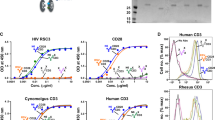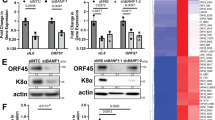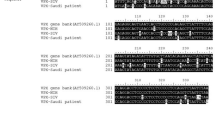Abstract
KAPOSI'S sarcoma (KS) is frequently associated with human immunodeficiency virus-1 (HIV-1) infection1. Supernatants from HIV-1-infected T cells carrying the CD4 antigen promote the growth of cells derived from KS lesions of AIDS patients (AIDS-KS cells)2, and the HIV-1 tat gene, introduced into the germ line of mice, induces skin lesions closely resembling KS3. Here we report that the tat gene product (Tat) is released from both HIV-1-acutely infected H9 cells and tat-transfected COS-1 cells. These Tat-containing supernatants specifically promote growth of AIDS-KS cells which are inhibited by anti-Tat antibodies; recombinant Tat has the same growth-promoting properties. Therefore a viral regulatory gene product can be released as a biologically active protein and directly act as a growth stimulator. These and previous data3 indicate that extracellular Tat could be involved in the development or progression, or both, of KS in HIV-1-infected individuals.
This is a preview of subscription content, access via your institution
Access options
Subscribe to this journal
Receive 51 print issues and online access
$199.00 per year
only $3.90 per issue
Buy this article
- Purchase on Springer Link
- Instant access to full article PDF
Prices may be subject to local taxes which are calculated during checkout
Similar content being viewed by others
References
Friedman-Kien, A. E. J. Am. Acad. Dermatol. 5, 468–471 (1981).
Nakamura, S. et al. Science 242, 426–430 (1988).
Vogel, J., Hinrichs, S. H., Reynolds, R. K., Luciw, P. A. & Jay, G. Nature 335, 606–611 (1988).
Salahuddin, S. Z. et al. Science 242, 430–433 (1988).
Delli Bovi, P. et al. Cancer Res. 46, 6333–6338 (1986).
Roth, W. K., Werner, S., Werner, R., Remberger, K. & Hofschneider, P. H. Int. J. Cancer 42, 767–773 (1988).
Albini, A. et al. J. cell Biochim. 36, 369–376 (1988).
Ensoli, B. et al. Science 243, 223–226 (1989).
Ensoli, B., Salahuddin, S. Z. & Gallo, R. C. Cancer Cells 1, 93–96 (1989).
Gallo, R. C. et al. Science 224, 500–503 (1984).
Aldovini, A. et al. Proc. natn. Acad. Sci. U.S.A. 83, 6672–6676 (1986).
Malim, M. H., Hauber, J., Le, S. Y., Maizel, J. V. & Cullen, R. B. Nature 338, 254–257 (1989).
March, C. J. et al. Nature 315, 641–647 (1985).
Auron, P. E. et al. Proc. natn. Acad. Sci. U.S.A. 81, 7907–7911 (1984).
Uski, K. et al. Proc. natn. Acad. Sci. U.S.A. 86, 7427–7431 (1989).
Abraham, J. A. et al. Science 233, 545–548 (1986).
Jaye, M. et al. Science 233, 541–545 (1986).
Frankel, A. D. & Pabo, C. O. Cell 55, 1189–1193 (1988).
Viscidi, R. P., Mayur, K., Lederman, H. M. & Frankel, A. D. Science 246, 1606–1608 (1989).
Laemmli, J. K. Nature 227, 680–685 (1970).
Chu, G., Hayakawa, H. & Berg, P. Nucleic Acids Res. 15, 1311–1325 (1987).
Author information
Authors and Affiliations
Rights and permissions
About this article
Cite this article
Ensoli, B., Barillari, G., Salahuddin, S. et al. Tat protein of HIV-1 stimulates growth of cells derived from Kaposi's sarcoma lesions of AIDS patients. Nature 345, 84–86 (1990). https://doi.org/10.1038/345084a0
Received:
Accepted:
Issue Date:
DOI: https://doi.org/10.1038/345084a0
This article is cited by
-
Murine leukemia virus (MLV) P50 protein induces cell transformation via transcriptional regulatory function
Retrovirology (2023)
-
Incident Kaposi sarcoma during the expansion of antiretroviral therapy eligibility in Nigeria: a retrospective cohort study
BMC Cancer (2023)
-
New insights into pathogenesis point to HIV-1 Tat as a key vaccine target
Archives of Virology (2021)
-
BK channels regulate extracellular Tat-mediated HIV-1 LTR transactivation
Scientific Reports (2019)
-
Case report: dual primary AIDS-defining cancers in an HIV-infected patient receiving antiretroviral therapy: Burkitt’s lymphoma and Kaposi’s sarcoma
BMC Cancer (2018)
Comments
By submitting a comment you agree to abide by our Terms and Community Guidelines. If you find something abusive or that does not comply with our terms or guidelines please flag it as inappropriate.



